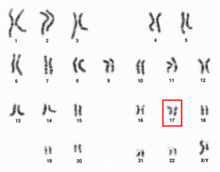| 17q12 microdeletion syndrome | |
|---|---|
| Other names | 17q12 deletion syndrome |
 | |
| The human karyotype with chromosome 17 highlighted | |
| Specialty | Medical genetics |
| Symptoms | Kidney problems, diabetes, reproductive anomalies, neuroatypicality |
| Usual onset | Conception |
| Duration | Lifelong |
| Causes | Chromosome microdeletion |
| Diagnostic method | Fluorescence in situ hybridization |
17q12 microdeletion syndrome, also known as 17q12 deletion syndrome, is a rare chromosomal anomaly caused by the deletion of a small amount of material from a region in the long arm of chromosome 17. It is typified by deletion of the HNF1B gene, resulting in kidney abnormalities and renal cysts and diabetes syndrome. It also has neurocognitive effects, and has been implicated as a genetic factor for autism and schizophrenia.
17q12 microdeletion syndrome is not to be confused with 17q12 microduplication syndrome, caused by the addition of genetic material in the same region from which it is removed in the microdeletion, or 17q21.31 microdeletion syndrome, another name for Koolen–De Vries syndrome.